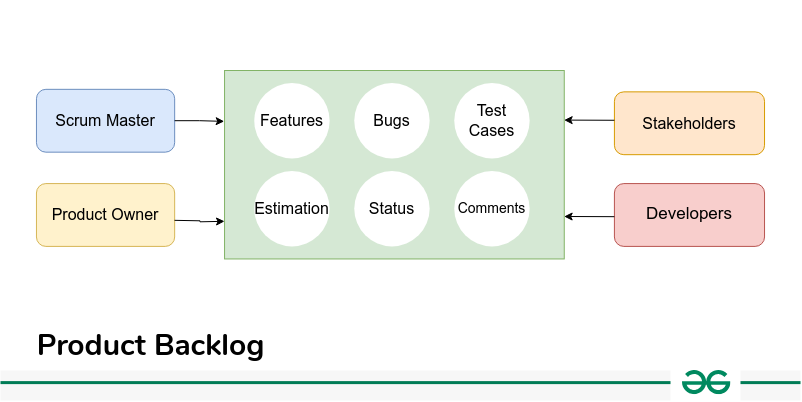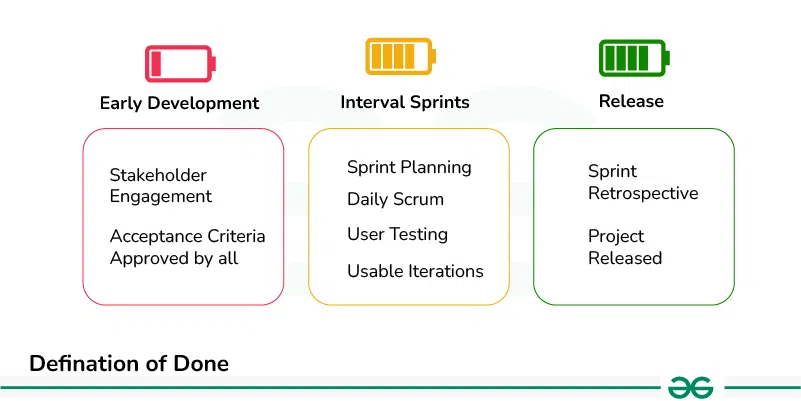The 7 Scrum Artifacts: Definitions and Examples
Last Updated :
23 Feb, 2024
Scrum artifacts are like the different tools and plans that you use in Project management and Product management. Scrum is the framework that is used in agile product management, and artifacts are the documents or objects created while the project is being developed that help keep everyone on the same page. So, Scrum Artifacts are just different ways to organize and track your project, making it easier to build something awesome. In total, there are seven artifacts in Scrum out of which Product Backlog, Sprint Backlog, and Product Increment are the three main artifacts. These artifacts help the Scrum team stay organized, understand what needs to be done, and track progress throughout product management.
What is Scrum Artifacts?
Scrum artifacts are like information tools in the Scrum way of working. They help the team and everyone interested in the project to know what’s happening with the product. They show what needs to be done, what’s currently being worked on, and what’s already finished. These artifacts make it easy for everyone to understand how the project is going and what’s happening at each step. There are 7 scrum artifacts.
The 7 Scrum Artifacts

The 7 Scrum Artifacts
The 7 Scrum artifacts are:
- Product Vision
- Product Backlog
- Sprint Vision
- Sprint Backlog
- Definition of Done (DOD)
- Product Increment
- Burndown Chart
Let’s dive deep into each artifact.
1. Product Backlog
The Product Backlog, as used in Scrum, is an ordered and dynamic list of all the tasks required to deliver a product. It is a crucial document that acts as the only reliable source of information about the features and requirements of the product for the Scrum team.
An important list of all the features, improvements, bug fixes, and other requirements that are used for creating a product is known as the product backlog. It is used for the whole range of possible tasks the development team could perform to produce the final product.
The product backlog consists of three distinct types of items:
- User Stories: These are high-level summaries of features, narrated from the viewpoint of the end-user of the product.
- Bugs: These are issues that have surfaced and require fixing, as identified by the product owner.
- Tasks: Assignments given to the Scrum team for completion.
The Product Backlog items should be properly explained and understood by the development team to enable efficient planning and setting priorities, even though they do not always need to be fully calculated or defined upfront. During backlog improvement sessions, the development team may offer estimates for backlog items to help the product owner in making well-informed decisions about setting priorities.
It includes user stories, epics, or any other product backlog items along with their priorities and estimates.

Product Backlog
2. Sprint Backlog
The tasks or work items that the Scrum team commits to finishing within a designated time frame, known as a sprint, which lasts for two to four weeks, are listed in the Sprint Backlog. It consists of all the tasks required to accomplish the sprint goal and serves as the team’s plan for the sprint.
The Scrum team creates the Sprint Backlog at the sprint planning meeting, which usually takes place at the start of each sprint. In this session, the team works together to identify user stories or backlog items from the Product Backlog and divides them into manageable tasks that can be finished in the sprint.
The sprint backlog is like a task board, usually divided into sections that show the stages of work. These sections often have these titles:
- To-Do: These are tasks that haven’t started yet.
- Doing: This is where the actual work is happening.
- To Verify: These are tasks that are finished but are waiting for another team member to check them.
- Done: This means the task is complete, and no more work is needed.
The work items or tasks that the Scrum team has committed to finishing during a sprint are listed in the Sprint Backlog, which is a dynamic list. It acts as the team’s execution strategy, offering transparency, focus, and flexibility to guarantee that the sprint goal is met on schedule.
It includes the user stories or tasks selected for the Sprint, along with their acceptance criteria, estimates, and the plan for completing the work.

Sprint Backlog
3. Product Vision
The Product Vision in Scrum acts as a roadmap or a long-term goal of a project/product. It serves as a symbol for the overall purpose of the product under development and gives the team members focus and direction. The Product Vision is also known as the high-level description of what the product aims to provide and the value it hopes to deliver to its users or customers. It should be clear, short, and easily understandable by all collaborators involved in the project.
- The product owner, who is in charge of representing the interests of the collaborators and making sure the product satisfies their needs, usually develops a product vision.
- To present a fascinating vision for the product, the product owner works with customers to understand their needs, market trends, and business objectives.
- The needs and priorities of stakeholders may change according to the time, new information may become available, or the market may change, all of which could cause the Product Vision to change.
- To make sure the Product Vision stays current and in line with the project’s overall goals, it is crucial for the product owner to constantly evaluate and improve it.
4. Sprint Goal
A Sprint Goal is a clear statement that outlines the objectives of the Scrum team for a given time frame known as a sprint, which typically lasts between two and four weeks. It gives the team’s work during the sprint direction and focus, directing them toward a single goal.
- Usually, the Sprint Vision defines the specific goal or outcome that the team desires will be achieved by the end of the sprint.
- It must be clear, quantifiable, and achievable in the given sprint time.
- During the sprint planning meeting, the Scrum team works to develop the Sprint Vision, receiving feedback from the product owner and other participants.
- To make sure that everyone gets the hang of the goals and expectations of the sprint, it is smoothed and finalized before the start of the sprint.
5. Definition of Done (DoD)
A Scrum team uses the Definition of Done (DoD), which functions similarly to a checklist, to make sure that a task, user story, or other piece of work is finished and satisfies the team’s quality standards. It acts as a common understanding among team members regarding what constitutes “done” for a given task.
- The Definition of Done serves primarily as a guide for expectations regarding the quality and thoroughness of work items.
- It facilitates an understanding of the requirements that must be satisfied for a task or user story to be considered release-ready by the team and stakeholders.
- The team and stakeholders evaluate whether each completed task or user story satisfies the Definition of Done during the Sprint Review. If something doesn’t fit the requirements, it’s not finished and needs to be adjusted before it can be released.

Definition of Done
6. Product Increment
The development team produces a physical, usable, and possibly releasable version of the product during a Sprint in Scrum, which is known as the Product Increment. It is a collection of all the features, improvements, and user stories that were finished and put to the test throughout the Sprint.
- The Product Increment is an end-user-useable, connected, and integrated version of the product, not just a collection of different features.
- It satisfies the Definition of Done and is potentially releasable, which means that customers or stakeholders may receive it if they so desire.
- By emphasizing producing a uniform and useful product, the Product Increment promotes teamwork and integration. In addition to ensuring that every team member works toward the same objective of providing value to the customer, it encourages cross-functional collaboration.
It includes all the features, enhancements, and fixes completed during the Sprint, providing a tangible and usable portion of the product.
7. Burndown Chart
A Burndown Chart is a visual that shows the amount of work that a team has finished over a given time frame, typically within a Scrum Sprint. Comparing the amount of work that needs to be done with the time allotted, helps the team determine whether they are on track to meet their objectives.
- As tasks are completed, the graph “burns down” to zero.
- The team’s progress is reflected in the Burndown Chart, which is updated frequently, sometimes even daily. The team may identify trends and modify their strategy as necessary to enhance their performance in upcoming Sprints by monitoring their progress over time.
Conclusion
These artifacts are related to one another and provide information. The product vision, for instance, directs the creation of the product backlog, which influences sprint planning and done definition, ultimately influencing the final product increment. These are the fundamental scrum artifacts, but other tools and artifacts may be used by the needs of the team and the particular project. Scrum projects must be managed and used effectively for these artifacts to be successful.
Frequently Asked Questions
1. Is the definition of done a Scrum artifact?
The Definition of Done (DoD) is not typically considered one of the core Scrum artifacts. Instead, it is a crucial concept within the Scrum framework that guides the Scrum Team on the criteria that must be met for a product increment to be considered complete and potentially releasable.
2. What are 3 roles 5 events and 3 artifacts in Scrum?
The 3 roles 5 events and 3 artifacts in Scrum are:
- 3 Roles: Product Owner, Scrum Master, and the Team.
- 5 Events: Sprint, Sprint Planning, Daily Scrum, Sprint Review, and Sprint Retrospective.
- 3 Artifacts: Product Backlog, Sprint Backlog, and Increment.
3. What is the most important artifact in Scrum?
The product increment is often considered as the critical artifact out of three artifacts in Scrum.
4. Who owns the sprint backlog?
The development team owns and maintains the sprint backlog.
Share your thoughts in the comments
Please Login to comment...